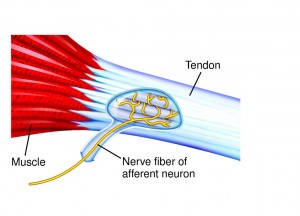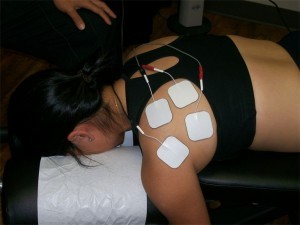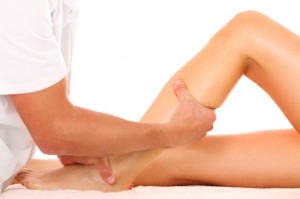Muscle Pain After Exercising?
Many of us experience muscle pain after exercising. Frequently, that pain will arise 6-12 hours after an exercise and last for up to 72 hours. This specific type of delayed onset muscle pain is not due to an injury to the muscle or tendon. But rather to a chemical change in the muscle resulting from the exercise itself. There are several types recovery strategies for dealing with the post-exercise muscle pain. Some work better than others and research supports several options. Proper recovery strategies focus on restoring blood flow and normal metabolite clearance in the muscles. Improper recovery strategies involve covering the pain with medications, including over-the-counter medications.

The nerve fiber leads from the GTO to the spine. The GTO measures muscle tension. It can be irritated by the build-up of lactic acid.
Post-exercise muscle pain is a result of chemical changes inside the muscle during vigorous use. As a muscle works, it burns fuel known as ATP. The muscle can make more fuel but it requires certain resources to do so. One important resource is oxygen. The muscle cells use oxygen to create fuel in a very efficient manner. When we do not have enough oxygen delivered to the muscle cells, they can still produce the ATP fuel but doing so produces byproducts like lactic acid. The lactic acid can build up inside the muscle and create the soreness that we are describing. Under normal circumstances, it takes the body a few days to clear out the lactic acid build-up. So, what are our options for a faster recovery?
Massage Therapy
There is a lot of scientific evidence and anecdotal cases to support massage therapy in treating post-exercise muscle pain. But unfortunately, there is a wide application of massage therapy so the results vary dramatically. For example, what technique of massage therapy would be applied? some examples include deep tissue, tapotement, effleurage, rolfing, trigger point therapy, lymphatic drainage, or even hot stone massage. Even if we agree on a technique, we need to consider timing the massage. Is it best applied before the exercise or after, and if after, how soon after? When applied, what is the treatment duration? Does a 15 minute treatment session work as well as a 60 minute session?
Zainuddin published an article in the Journal of Athletic Training which showed that massage applied the muscle following the exercise was able to reduce muscle pain by approximately 30 percent.
Some researchers have looked at providing massage therapy prior to the exercise. Shagufta, et al. looked at providing massage therapy for 15 minutes, applied prior to the exercise. The results showed that the post-exercise pain was reduced and in some cases prevented
Stretching
It seems that every list of treatments includes muscle stretching prior to exercise. We all see athletes stretching prior to their event, whether its running, weight-lifting, little league baseball, or golf. We have all been told to stretch by our amateur coaches. Stretching helps to reduce risk of muscle and tendon injury. But does stretching help prevent or reduce post exercise mucle pain? It turns out that there is no benefit. Stretching may still be a good idea and probably should be incorporated into your warm-up routine for injury prevention. But as far as post-exercise muscle pain, there is no benefit. Several research articles and reviews (including a Cochrane Review) have all reached the same conclusion.
Ice Packs
Cryotherapy strategies, such as ice packs, and ice baths have been used for many years and research does support continued use. Just like with massage therapy, there are several methods of application and treatment times, so its difficult to get a consensus on ‘best practice.’
The aim of cryotherapy is to reduce the chemical reactions associated with inflammation. As described above, the lactic acid can cause inflammation and sensitivity of nerves. Those chemical process can be slowed down with ice therapy. Personally, I have not been a fan of the whole-body immersion cryotherapy (ice bath). It seems that it would drive the blood from the muscles and thereby prolong the injury. But the research seems to support the idea, so I may have to revise my position on this therapy.
Electrical Muscle Stimulation
 Following the exercise, when there is a build-up of lactic acid, therapies which promote the evacuation of the chemical agents tend to fair better than those which reduce the inflammation reaction. In the case of electrical muscle stimulation (EMS), evacuation of the lactic acid from the muscle is achieved by a pumping action induced by the muscle twitching. Think of a dirty sponge being repeatedly squeezed while under water.
Following the exercise, when there is a build-up of lactic acid, therapies which promote the evacuation of the chemical agents tend to fair better than those which reduce the inflammation reaction. In the case of electrical muscle stimulation (EMS), evacuation of the lactic acid from the muscle is achieved by a pumping action induced by the muscle twitching. Think of a dirty sponge being repeatedly squeezed while under water.
During EMS, electrode pads are placed on the skin and a mild electrical current is passed through the pads. The mild current stimulates the muscle to contract. By setting the frequency and pulse width of the current, the muscles can be contracted in patterns which promote increased blood flow and metabolite evacuation. There are several types of EMS available. My favorite is called interferential. It is very comfortable and my patients often describe it as an ‘electical massage.’ Treatment times average about 10 minutes. One additional benefit of the EMS is the stimulation of enkephalin, which is a peptide produced by the body which helps to reduce pain perception.
Conclusion
Muscle pain following exercise can result from the build up of lactic acid and other metabolites in the muscle tissue. There are several low-cost options available for the treatment of post-exercise muscle pain. Some therapies work better than other and have research to support them. Massage therapy shows the most promise if it is applied correctly. Cryotherapy and EMS also show benefit. In my St George Utah chiropractic office we can offer the EMS therapy to patients who are suffering from post-exercise muscle pain.
Dr. Andrew White | St George Chiropractor
References
- Zainuddin Z, et al. Effects of massage on delayed-onset muscle soreness, swelling, and recovery of muscle function. J Athl Train, 2005. Jul-Sep; 40(3):174-80.
- Moraska A. Sports massage: a comprehensive review. J Sports Med Phys Fitness, 2005 Sep;45(3):370-80.
- Han JH, et al. Effects of therapeutic massage on gait and pain after delayed onset muscle soreness. 2014. J Exerc Rehabil, Apr 30;10(2):136 -40.
- Shafufta I, et al. To compare the effect of vibration therapy and massage in prevention of delayed onset muscle soreness (DOMS). J Clin Diagn Res, 2014 Jan;8(1):133-136.
- Andersen LL, et al. Acute effects of massage or active exercise in relieving muscle soreness: randomized controlled trial. J Strength Cond Res, 2013 Dec;27(12):3352-9.
- Kargarfard M, et al. Efficacy of massage on muscle soreness, perceived recovery, physiological restoration and physical performance in male bodybuilders. J Sports Sci, 2015 Sep 3:1-7.
- Hohenauer E, et al. The effect of post-exercise cryotherapy on recovery characteristics: a systematic review and meta-analysis. PLoS One, 2015 Sep 28;10(9):11.
- Roberts LA, et al. Post-exercise cold water immersion attenuates acute anabolic signalling and long-term adaptations in muscle to strength training. J Physiol, 2015 Sep;593(18):4285-301.



